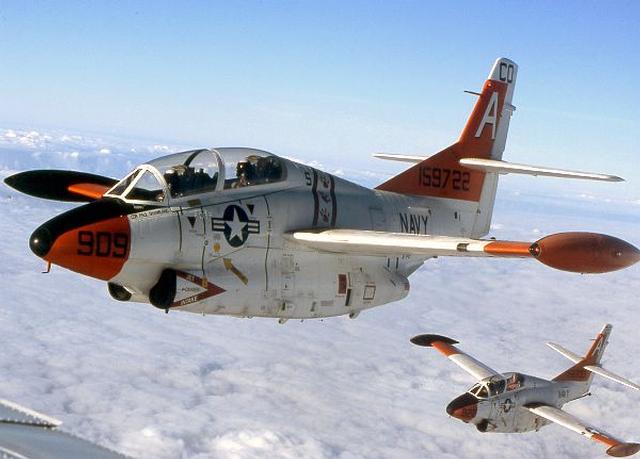|

U.S. Navy photo by Ensign Darin K. Russell.
History: When, in 1956, the U.S. Navy
requested competitive designs for a new jet trainer capable of taking their student pilots
through advanced combat flight categories such as gunnery, fighter tactics, bombing, and
carrier qualification, North American Aviation emerged the winner with its design, which
used proven features from operational North American aircraft like the FJ-1 Fury and T-28 Trojan. Skipping the prototype phase, North American (purchased by
Rockwell, which was later purchased by Boeing) went straight to the pre-production stage,
building six YT2J-1 aircraft for evaluation. Of mid-wing
configuration, the aircraft had tandem LS-1 ejection seats for pupil (front) and
instructor (rear). The instructor's seat was raised to provide a good view, with full dual
controls so the aircraft could be controlled from either seat. The first of the YT2J-1s
flew on January 31, 1958.
Built with student pilots in mind, the Buckeye, as it was called, had a strong, wide-based
tricycle landing gear, powered controls, large trailing-edge flaps, air brakes on both
sides of the fuselage, and a retractable arrester hook, all of which were hydraulically
actuated. The YT2-J1 was powered by a single 3400-pound thrust Westinghouse J34-WE-48
fuselage-mounted turbojet, as were the initial T2J-1 production
models (T2-A after 1962). 201 of this version were produced, the
first entering service in July, 1959.
In August, 1962, the first of two YT2J-2 test aircraft were
converted from T2J-1 configuration by replacing the single turbojet with two 3,000-pound
thrust Pratt and Whitney J60-P-6 turbojets. This conversion was chosen to replace the
T-2A, and the first of 97 new T-2B aircraft flew on May 21, 1965
and entered service in December, 1965 with Training Squadron VT-4 at Pensacola Naval Air
Station.
Next, the T-2B was converted to a YT-2C for evaluation of the
aircraft with two General Electric J85-GE-4 engines. This led to the manufacture of 231 T-2Cs
with the GE powerplants for the U.S. Navy Training Command, with the first production
model being flown on December 10, 1968.
A few T-2B and T-2C aircraft were converted for service as drone directors under the
designations of DT-2B and DT-2C,
respectively, while two additional variants of the T-2C were procured for the Venezuelan (T-2D)
and Greek (T-2E) air forces. Capable of carrying a wide variety
of training weapons packages on two wing mounts, the Buckeye could be upgraded to a
six-mount status via an armament accessory kit that made the aircraft an effective light
attack aircraft capable of carrying bombs, rockets and gun pods.
The Buckeye was well-designed for field maintenance conditions, with serviceable
components installed at waist level or lower. Thus, the need for stands and ladders for
most routine maintenance, including fueling, was eliminated.
While training more than 11,000 student pilots to fly 18 different models of Navy jet
aircraft, the Buckeye established an outstanding record of safety and reliability for many
years, but as the machine has aged it has developed some problems, being grounded for
safety reasons three times in 1997 alone. After 41 years of service, the North American
T-2 "Buckeye" jet trainer was phased out in favor of the Boeing/BAE
T-45A "Goshawk." The final flight of the T-2 in U.S. military
service was in 2015. At least two T-2s have made their way into civilian ownership.
Nicknames: Attack Guppy; Trusty Tubbyjet
Specifications (T-2C):
Engine: One 2,950-lb thrust General Electric J85-GE-4 turbojet
Weight: Empty 8,115 lbs., Max
Takeoff 13,180 lbs.
Wing Span: 38ft. 2in.
Length: 38ft. 8in.
Height: 14ft. 9.5in.
Performance:
Maximum Speed:
521 mph
Ceiling: 44,400
ft.
Range: 910 miles
Armament: None
Number Built: 529
Number Still Airworthy:
At least two are privately-owned and operated as warbirds. The type is still
operated by the Hellenic (Greek) Air Force in small numbers.
Links:
Aviation
Enthusiast's Corner: T-2 Buckeye
Federation of American
Scientists -- T-2 Buckeye page
Ken's Aviation Photography: T-2 photos
North American
Company History (at Boeing.com) -- T-2 Page
Photovault
T-2 Photo Page
Warbird Heritage Foundation's T-2 Buckeye

[Back to Warbird Alley's Main
Page]
All text and photos Copyright 2015 The
Doublestar Group, unless otherwise noted.
You may use this page for your own, non-commercial reference purposes only.

|